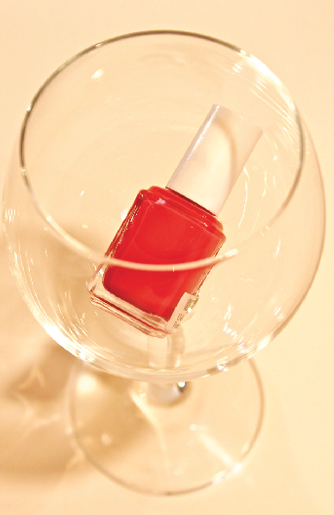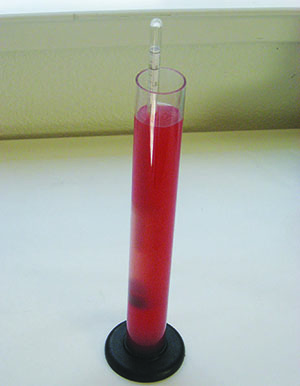
Finally, that moment of truth: The fruits of your labor are ready to taste. Perhaps the fermentation is finally completed, or you’ve just opened the first bottle. You cross your fingers and take the plunge. Nectar of the gods? Or foul, demonic brew?
There are few things more heartbreaking than discovering that your hours of toil and weeks of waiting have yielded little to be proud of. Sometimes things go wrong, and the result is off-flavors. But most wine defects are easily prevented with good sanitation and a few simple winemaking techniques.
Microbial contamination comes in myriad forms and causes even more varied results in your wine. The basic principle is to try to keep microbes from getting into the wine in the first place and keep them from growing or producing byproducts when they are present. Molds, yeasts, and bacteria can all cause problems that affect fermentation and flavor. Here’s a look at some common ones and how to prevent them.
Acetobacter
Acetobacter is almost unavoidable in winemaking, but its population and effects can be controlled. Acetobacter is a bacteria that grows anywhere the wine is in contact with oxygen. It produces both acetic acid and ethyl acetate. Acetic acid has a vinegar aroma, and ethyl acetate can smell like fake fruit at low concentrations or nail polish remover at very high levels. To prevent high volatile acidity levels (caused by Acetobacter), make sure all surfaces that the wine comes in contact with are sanitized. Also avoid barrels that have contained vinegar or wines with very high VA levels. Adding SO2 (sulfur dioxide) to the wine will inhibit the growth of this bacteria. Also, because the bacteria needs oxygen to grow, avoid oxygen contact by keeping containers topped and sealed as much as possible.
Hydrogen Sulfide
Hydrogen sulfide (H2S) is an especially unpleasant problem but fairly easily avoided. There are a variety of causes of this rotten-egg-smelling gas, including elemental sulfur present on the fruit surface, poor vine nutrition, rapid or especially warm fermentation (higher than 90 °F/32 °C), and yeast autolysis.
To prevent H2S production in your wine, the first step is aeration. If done when the smell is first noticed, aerating will solve the problem. Also, use a slow-fermenting yeast (avoid a strain called Montrachet if you’re having problems with H2S) or ferment at cooler temperatures (50 to 60 °F/10 to 16 °C; cooler for whites, warmer for reds to extract color), make sure adequate time has been allowed after sulfur spraying and before picking, and add yeast nutrient to ensure ample nutrition in the wine. If the wine is left on the lees for an extended period of time, say more than six months, the breakdown of yeast cells (autolysis) can cause H2S production, so racking is recommended.
If you do get some H2S in your wine, don’t panic. Copper sulfate (CuSO4) can eliminate it. Although CuSO4 is highly poisonous in high concentrations, a maximum of 0.004 gram per gallon is acceptable. The best way to do this is to add tiny bits at a time and smell after each addition. When the aroma is gone, you’ve added enough. There are health concerns with adding high levels of copper (and legal limits if you’re selling your wine), but a wine is not likely to have so much H2S that you would have to exceed reasonable levels.
The Wild Ones
Wild yeast can cause some interesting things to happen to a wine. Many winemakers choose to allow a wild or “natural” yeast to either start a fermentation or work to completion to encourage what many call “complexity.” This essentially means unexpected flavors. However, there is no guarantee that these unexpected flavors will be good ones or that the yeast will be the same ones or have the same effects every time.
One “complex” flavor, known as “barnyard” (also referred to as horsy, mousy, wet dog, or hamster urine), is caused by the notorious Brettanomyces yeast. The finest, most competent winemakers in the world take notice of this little guy, known affectionately as “Brett.” Some people find these aromas less worrisome than others, but it is generally wise to avoid wild yeast if you wish to have consistent results.
Inoculating immediately after crushing with a yeast known to perform well will impair native or spoilage yeasts’ efforts to grow to high enough populations to cause any off-flavors. A good wine yeast strain will quickly raise the ethanol level high enough to be toxic to many bacteria and wild yeast and will out-compete them for the nutrition available in the juice.
Aside from yeast selection, make sure all containers are sanitized before use. Old barrels, especially, can be great sources for contamination. An additional reason for inoculating rather than depending on wild yeast is that many wild yeast cannot ferment grape juice to dryness or will start slowly. Slow starts pose the risk of contamination, off-flavors, and incomplete fermentation.
Second Time Around
Another problem caused by microorganisms is unwanted secondary fermentation. Secondary fermentations are most notably a problem after bottling but can cause off-flavors in a wine after the primary fermentation, when it is waiting to be bottled. Malolactic fermentation, one type of secondary fermentation, is necessary for stabilization (the less desirable alternative being sterile filtration), is often unavoidable, and can create some desirable aromas and flavors. In general the group of bacterial strains that convert malic acid to lactic acid (such as Lactobacillus or Leuconostoc) during malolactic fermentation are good for de-acidifying tart wines.
Although not a direct factor, malo-lactic fermentation can contribute to the production of diacetyl, resulting in buttery or creamy flavors and mouthfeel. Diacetyl most often results when winemakers fail to add SO2, thereby allowing oxidation, and when wine goes slowly through malo-lactic fermentation. But many of these bacteria can also cause some undesirable flavors and can render a high pH wine flat-tasting.
In addition malolactic fermentation, fermentation of residual sugars by yeast, and any other bacterial fermentation after bottling can cause carbon-dioxide bubbles in the wine, which poses the risk of pushed corks, ruptured bottles, and general fizziness.
To prevent such mishaps, either allow the malolactic fermentation to run its course before bottling, using up all the malic acid in the juice, or add SO2 at bottling and keep your wine chilly at all times.
Test for sugar before bottling to assess the risk of a little sparkle. Sugar levels should be below 0.2 gram per liter when using a Clinitest or minus one on a Balling scale. Also, make sure malolactic fermentation has completed. Do this by listening to make sure the wine has stopped fizzing, usually after a couple of weeks. Filtering also helps reduce unwanted bacterial and yeast populations, and sterile filtering can eliminate them altogether. Sterile filtering and SO2 additions are especially recommended if you plan to leave the wine a little sweet.
Less common is the aroma of “corkiness” caused by the activity of molds in chlorine. The swampy aroma of trichloroanisole can make a wine undrinkable. Luckily, it only happens if there is just the right kind of mold growing on either corks or barrels and chlorine is also present. The mold, with the chlorine in its environment, then produces trichloranisole. Corks bleached in chlorine are the main culprit. So if you use chlorine bleach to sanitize, rinse very thoroughly — several times. Also, make sure to use fresh, clean corks, and sanitize barrels as well as you can. Very hot water helps sanitize by killing most microorganisms, but using a sulfite solution is a much safer route.
Prevent Oxidation
Living things are not the only cause of wine problems. Oxidation can also render a wine undrinkable. Oxygen contact can cause browning, especially in white wines, and flavors associated with sherry. While these aromas are delicious in sherry, you may not like them as much in your Chardonnay. The best way to combat oxidation is obvious: Prevent oxygen from touching the wine. During vigorous fermentation, the yeast will displace all of the oxygen available in the must with CO2. But afterward, it is best to keep your containers topped and covered and try to move and splash the wine as little as possible. Sulfite, which releases SO2, can be used to prevent browning as well as microbial growth. A little SO2 gas will escape each time you rack a wine, so you may want to add some sulfite with each racking to make up for it.
Unfortunately, SO2 is a double-edged sword. High sulfite levels can also be a problem. Measure your sulfite additions carefully. Some will be absorbed by the wine, but most will remain in the unbound, active form. If you can test for free SO2, don’t let it get above 30 parts per million or so. Any level higher than that may be detectable by taste or smell. Its smell is usually described as sharp, pungent, or a feeling similar to smelling ammonia.
Inadequate stirring or undissolved SO2 can cause incorrect results when testing for SO2 concentration, so make sure it has dissolved well and is equally distributed in the wine. Also, though Saccharomyces yeast are more resistant to SO2’s antimicrobial activity, high levels will retard or stop the growth and activity of yeast. Additions of SO2 prior to fermentation should therefore be done as accurately and carefully as possible and to a reliable recipe or formula.
Inexperienced winemakers recommend taking out excess SO2 by adding hydrogen peroxide and cooking the wine. Under no circumstances is this advised. If you’ve never tasted cooked wine, you may be tempted to try this. However, it is probably better to avoid the problem in the first place.
Stuck Fermentation
A stuck fermentation can contribute to off-flavors. There is nothing quite like a pot or jar or barrel of sweet muck just sitting there, not doing much of anything. Stuck fermentations can be a major sensory or stylistic problem. Wine styles meant to be dry can taste drastically different with even the slightest amount of residual sugar. Not only does sugar add sweetness, but it also puffs up the mouthfeel, making the wine seem thicker and creamier, less acidic, and less tannic. Also, sugar and low alcohol levels invite bacteria, yeast, and even mold, making your wine vulnerable to contamination by undesirable microbes and their effects.
The most frequent type of stuck fermentations seem to have no cure. But there are many other types that can be prevented. Causes of stuck fermentations include but are certainly not limited to restricted nutrition for yeast, excess sugars (high Brix), ethanol toxicity (strain is not tolerant of high alcohol and/or limited oxygen and the yeast can’t grow), toxic substances (excess SO2, fungicide/pesticide residues, certain organic acids), and temperature shock (too cool or hot).
Things that can be done to either prevent or fix most of these problems. Nutrients can be added to the must to make sure that the yeast are healthy and perform the fermentation to dryness. If the wine has been stuck very long, it may be necessary to re-inoculate with a new starter culture in fresh medium. Add portions of the stuck must during vigorous fermentation to the fresh culture. Then add that combination back to the original must.
If your stuck fermentation is the result of chemicals in the juice, there may be no cure. Residues of fungicides and pesticides are toxic, as well as the byproducts of some microorganisms. So make sure that the grapes are picked at a safe time after spraying with any fungicides or pesticides (it’s a good idea to avoid sulfur, too) to make sure that your yeast aren’t killed by these agents. Sulfite is also inhibitory, so if levels are too high during fermentation (more than 30 ppm), wild yeast and bacteria may be inhibited, but the yeast you selected may also be. An initial addition of SO2 in the crusher won’t have as much effect as if it were added during fermentation, because much of the sulfite becomes bound in the solution and is not free to inhibit. Make sulfite additions carefully.
The Right Temperature
A very low temperature will slow yeast metabolism. If your must is cool, in the low 40° F range, and the fermentation is going slowly, just gently warm it to 50° F for whites and 80° F for reds. Warmth may be easily retained by using insulated fermentation containers.
High temperatures can also inhibit yeast, and very high temperatures can kill them. Above 100 °F (38 °C) yeast may die and “cooked” flavors may also result. If you are using insulated fermenters, transferring the must to an uninsulated one may be enough to do the trick. If it is still getting too warm, a cool water bath may be necessary. If you have a refrigerator set to a cool temperature (45 to 60 °F/7 to 16 °C), that is ideal. If it’s any colder than that, the fermentation is likely to stop. The temperature can rise amazingly quickly, so it is best to take a temperature reading at least twice a day during vigorous fermentation.
Fermentation is a dynamic process. Musts and wines are constantly changing. And as with most things in life, worst-case scenarios are not likely to occur. Much wine sort of seems to make itself. Following good sanitation and winemaking practices is just insurance against nature getting the best of you. And if something does go wrong, learn from it and try to avoid it in the future.




